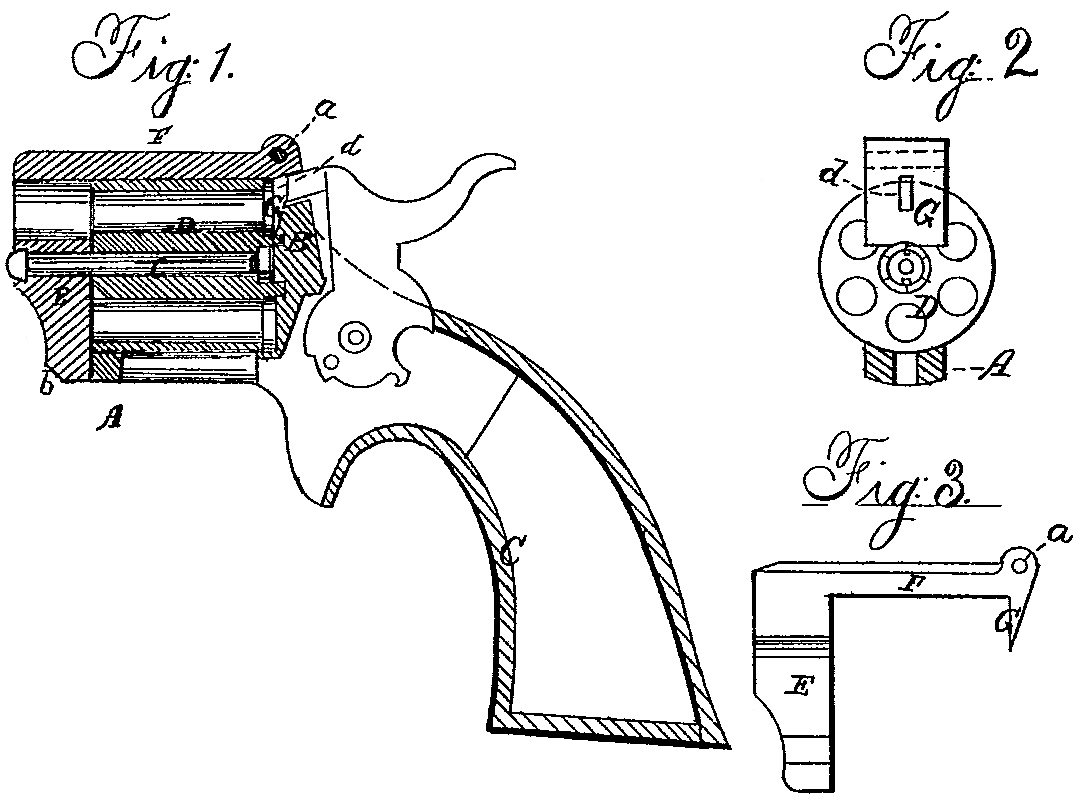US 35623
UNITED STATES PATENT OFFICE.
LUCIUS W. POND, OF WORCESTER, MASSACHUSETTS.
IMPROVEMENT IN REVOLVING FIRE-ARMS.
Specification forming part of Letters Patent No. 35,623, dated June 17, 1862.
To all whom it may concern:
Be it known that I, LUCIUs W. POND, of Worcester, in the county of Worcester and State of Massachusetts, have invented a new and useful Improvement in Revolving Fire-Arms; and I do hereby declare that the following is a full, clear, and exact description of the same, reference being had to the accompanying drawings, forming part of this specification, in which—
Figure 1 is a longitudinal central section of the frame and many-chambered cylinder of a pistol with my improvement. Fig. 2 is a transverse section of the frame in rear of the cylinder. Fig. 3 is a side view of the upper portion of the frame.
Similar letters of reference indicate corresponding parts in the several figures.
This invention relates to cylinder-revolvers having their cylinder-frames made to open at the lower front corner by a movement on a hinge-joint at the upper rear corner for the purpose of introducing the cartridges into the chambers from the rear of the cylinder; and it consists in a downward continuation of the upper part of such frame to pass over the rear of the cylinder at the point where the hammer strikes the cartridge in such a manner as to form a recoil-shield which is wholly or nearly independent of the breech-piece or usual recoil-plate and of the lower part of the cylinder-frame, thereby relieving the said piece or plate and the hinge-joint of the strain of the recoil.
To enable others skilled in the art to apply my improvement, I will proceed to describe it with reference to the drawings.
A B C is the piece which constitutes the bottom and back of the cylinder-frame and the frame of the stock, the part B being what is variously called the “recoil-plate” and “breech-piece,” and covering the rear of the cylinder D.
E F G is the piece which constitutes the top and front of the breech-frame and the recoil-shield, the part G being the downward continuation of the upper part to form the recoil-shield, which constitutes my invention. a is the hinge-joint, from which the movement of the two pieces to open and close at b takes place. The downward continuation G is of a width and depth to cover the rear of the upper chamber, which is in line with the barrel and opposite the hammer. Its front face is square with the top part, F, of the frame and with the cylinder axis-pin C, which is secured in and attaches the cylinder to the part E. Its rear face is beveled, as shown in Fig. 3, to enable it to fit, the back of a, beveled? recess in the recoil-plate or breech-piece B when the frame is closed, as shown in Fig. 1, the said recess being just wide enough for its reception. When the frame is closed the front face of G is flush with the front face of B, so that the cartridges in the cylinders revolve without striking the edges of either, and pass smoothly over the joint. Space is left between G and the rear of the cylinder for the flanged portion of the cartridge.
In Fig. 1 a cartridge is shown in the upper chamber in red outline.
d is a slot provided in G for the point of the hammer to work through. When the cartridges are fired the downward continuation G receives the force of the recoil, which in its absence would be received by the recoil-plate or breech-piece B and bring a strain upon the hinge joint; but the continuation G prevents this strain.
What I claim as my invention, and desire to secure by Letters Patent, is—
The combination, with a cylinder-frame made in two pieces, hinged together at the upper rear angle, of a downward extension, G, of the up per part of the frame below the hinge-joint, substantially as and for the purpose herein specified.
LUCIUS W. POND.
Witnesses:
E. B. Stoddard,
Edward D. Holton.

